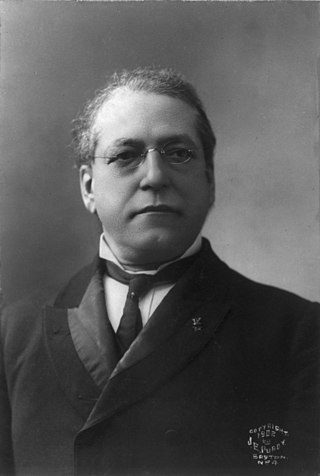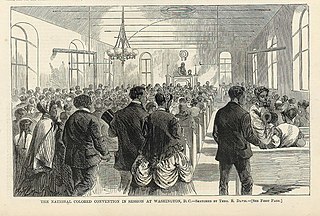Organizational history
The National Labor Union (NLU) followed the unsuccessful efforts of labor activists to form a national coalition of local trade unions. The NLU sought instead to bring together all of the national labor organizations in existence, as well as the "eight-hour leagues" established to press for the eight-hour day, to create a national federation that could press for labor reforms and help found national unions in those areas where none existed. The new organization favored arbitration over strikes and called for the creation of a national labor party as an alternative to the two existing parties.
The NLU drew much of its support from construction unions and other groups of skilled employees but also invited the unskilled and farmers to join. On the other hand, it campaigned for the exclusion of Chinese workers from the United States and made only halting, ineffective efforts to defend the rights of women and Black people. African-American workers established their own Colored National Labor Union as an adjunct, but their support of the prevalent racism of the citizens of the United States limited its effectiveness.
The NLU achieved early success, but one that proved less significant in practice. In 1868, Congress passed the statute for which the Union had campaigned so hard, providing the eight-hour day for government workers. Many government agencies, however, reduced wages at the same time that they reduced hours. While President Grant ordered federal departments not to reduce wages, his order was ignored by many. The NLU also obtained similar legislation in a number of states, such as New York and California, but discovered that loopholes in the statute made them unenforceable or ineffective.
In early 1869, the Chicago Tribune boasted that the NLU had 800,000 members; Sylvis himself put the figure at only 600,000. Both of these figures turned out to be greatly exaggerated. [2] The organization was spectacularly unsuccessful at the polls and lost virtually all of its union supporters, many of whom moved on to the newly formed Knights of Labor. The depression of the 1870s, which drove down union membership generally, was one of the final factors contributing to the end of the NLU, the other being the dismantling of policies instituted during Radical Reconstruction.

Samuel Gompers was a British-born American cigar maker, labor union leader and a key figure in American labor history. Gompers founded the American Federation of Labor (AFL) and served as the organization's president from 1886 to 1894, and from 1895 until his death in 1924. He promoted harmony among the different craft unions that comprised the AFL, trying to minimize jurisdictional battles. He promoted thorough organization and collective bargaining in order to secure shorter hours and higher wages, which he considered the essential first steps to emancipating labor.

The American Federation of Labor was a national federation of labor unions in the United States that continues today as the AFL–CIO. It was founded in Columbus, Ohio, in 1886 by an alliance of craft unions eager to provide mutual support and disappointed in the Knights of Labor. Samuel Gompers was elected the full-time president at its founding convention and was re-elected every year except one until his death in 1924. He became the major spokesperson for the union movement.

The Federation of Organized Trades and Labor Unions of the United States and Canada (FOTLU) was a federation of labor unions created on November 15, 1881, at Turner Hall in Pittsburgh. It changed its name to the American Federation of Labor (AFL) on December 8, 1886.
The eight-hour day was a social movement to regulate the length of a working day, preventing excesses and abuses of working time.
The following is a timeline of labor history, organizing & conflicts, from the early 1600s to present.
Gompers v. Buck's Stove and Range Co., 221 U.S. 418 (1911), was a ruling by the United States Supreme Court involving a case of contempt for violating the terms of an injunction restraining labor union leaders from a boycott or from publishing any statement that there was or had been a boycott.
Dual unionism is the development of a union or political organization parallel to and within an existing labor union. In some cases, the term may refer to the situation where two unions claim the right to organize the same workers.

Established in 1869, the National Labor Union, more commonly known as the Colored National Labor Union (CNLU), was formed by African Americans to organize their labor collectively on a national level. The CNLU, like other labor unions in the United States, was created with the goal of improving the working conditions and quality of life for its members.
The National Building Trades Council (NBTC) was an American federation of labor unions in the construction industry. It was active from 1897 to 1903.
The Structural Building Trades Alliance (SBTA) was an American federation of labor unions in the construction industry. It was founded in 1903 and existed until 1908, when it affiliated with the American Federation of Labor (AFL) and became the Building Trades Department.
Labor federation competition in the United States is a history of the labor movement, considering U.S. labor organizations and federations that have been regional, national, or international in scope, and that have united organizations of disparate groups of workers. Union philosophy and ideology changed from one period to another, conflicting at times. Government actions have controlled, or legislated against particular industrial actions or labor entities, resulting in the diminishing of one labor federation entity or the advance of another.

Michael D. Ratchford was an Irish-American labor leader and president of the United Mine Workers of America (UMWA) from 1897 to 1898. Ratchford is remembered for his leadership of a coal strike during the summer of 1897, which lead to the establishment of a national scale of wages and hours for the industry.

James Duncan was a Scottish American union leader, and president of the Granite Cutters' International Association from 1895 until his death in 1928. He was an influential member of the American labor movement, helping to co-found the American Federation of Labor.
The Union Labor Party was a San Francisco, California working class political party of the first decade of the 20th century. The organization, which endorsed the doctrine of nativism, rose to prominence in both the labor movement and urban politics in the years after 1901, electing its nominee as Mayor of San Francisco in 1901, 1903, 1905, and 1909.

The 1926 Passaic textile strike was a work stoppage by over 15,000 woolen mill workers in and around Passaic, New Jersey, over wage issues in several factories in the vicinity. Conducted in its initial phase by a "United Front Committee" organized by the Trade Union Educational League of the Workers (Communist) Party, the strike began on January 25, 1926, and officially ended only on March 1, 1927, when the final mill being picketed signed a contract with the striking workers. It was the first Communist-led work stoppage in the United States. The event was memorialized by a seven reel silent movie intended to generate sympathy and funds for the striking workers.
The Mechanics' Union of Trade Associations was an American trade union founded in Philadelphia, Pennsylvania, in 1827.

William H. Sylvis (1828–1869) was a pioneer American trade union leader who founded the Iron Molders' International Union. He also was a founder of the National Labor Union. It was one of the first American union federations attempting to unite workers of various crafts into a single national organization.

The Switchmen's Union of North America (SUNA) was a labor union formed in October 1894 that represented the track switch operators and people who coupled railway cars in railway yards in the United States and Canada. It became part of the United Transportation Union in 1969.
The International Workingmen's Association in the United States of America took the form of a loose network of about 35 frequently discordant local "sections," each professing allegiance to the London-based IWA, commonly known as the "First International." These sections were divided geographically and by the language spoken by their members, frequently new immigrants to America, including those who spoke German, French, Czech, as well as Irish and "American" English-language groups.









